Tambura may refer to:
Tambura may refer to:

The oud is a Middle Eastern short-neck lute-type, pear-shaped, fretless stringed instrument, usually with 11 strings grouped in six courses, but some models have five or seven courses, with 10 or 13 strings respectively.
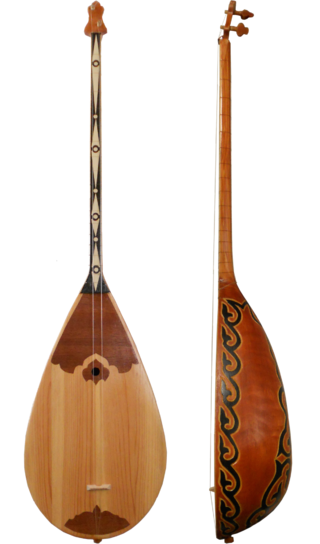
The dombra, also known as dombyra, is a long-necked musical string instrument used by the Kazakhs, Hazaras, Uzbeks, Tajiks, Nogais, Bashkirs, and Tatars in their traditional folk music. The dombra shares certain characteristics with the komuz and dutar instruments, such as its long, thin neck and oblong body shape. It is a popular instrument mostly among Turkic communities in Central Asian countries.
Tambora may refer to:
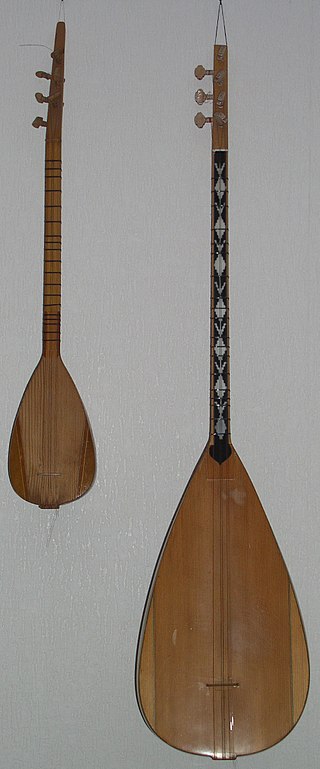
The bağlama or saz is a family of plucked string instruments and long-necked lutes used in Ottoman classical music, Turkish folk music, Turkish Arabesque music, Azerbaijani music, Bosnian music (Sevdalinka), Kurdish music, and Armenian music. It is played in several regions in the world such as Europe, Asia, Black Sea, Caucasus regions and many countries including Syria, Iraq, Iran and Bosnia and Herzegovina. It is commonly used by the ashiks.

The tanpura is a long-necked, plucked, four-stringed instrument originating in the Indian subcontinent, found in various forms in Indian music. Visually, the tanpura resembles a simplified sitar or similar lute-like instrument, and is likewise crafted out of a gourd or pumpkin.

The cümbüş is a Turkish stringed instrument of relatively modern origin. It was developed in 1930 by Zeynel Abidin Cümbüş as an oud-like instrument that could be heard as part of a larger ensemble.
Tamburica or tamboura refers to a family of long-necked lutes popular in Southeast Europe and Central Europe, especially Serbia, Bosnia and Herzegovina, Croatia, Slovenia, and Hungary. It is also known in Burgenland, Austria. All took their name and some characteristics from the Persian tanbur but also resemble the mandolin and guitar in the sense that its strings are plucked and often paired. The frets may be moveable to allow the playing of various modes. The variety of tamburica shapes known today were developed in Serbia and Croatia by a number of indigenous contributors near the end of the 19th century.
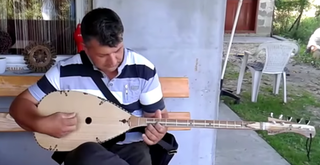
The šargija, anglicized as shargia, is a plucked, fretted long necked lute used in the folk music of various Balkan countries, including Bosnia and Herzegovina, Serbia, Albania, and North Macedonia. The instrument is part of a larger family of instruments which includes the Balkan tambura and the saz, tamburica, and the tambouras.
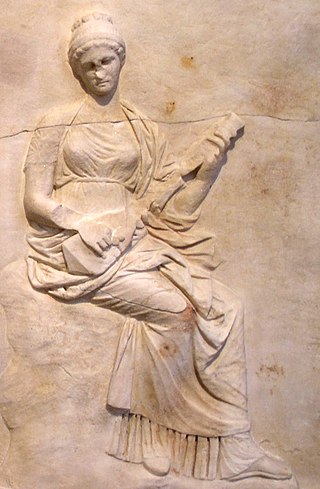
The pandura or pandore, an ancient string instrument, belonged in the broad class of the lute and guitar instruments. Akkadians played similar instruments from the 3rd millennium BC. Ancient Greek artwork depicts such lutes from the 3rd or 4th century BC onward. Iranian influences are indicated by the Persian origin of the word.
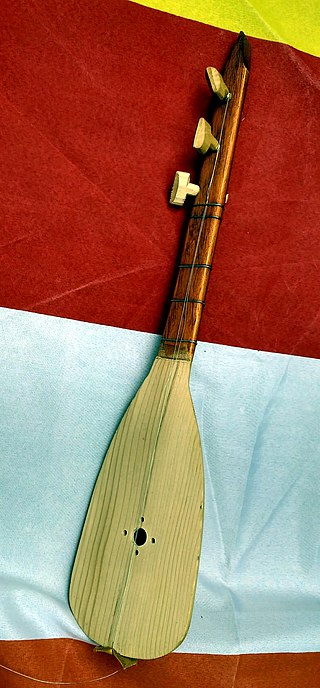
The dangubica or samica is a small Serbian and Croatian stringed instrument, having either two single or two double strings, a long, fretted neck, and a pear-shaped body. One string is used to play the melody, while the second plays a continuous note, known as the drone. Loosely translated, the word danguba means "to lose the day," referring to the instrument's origins among shepherds, who usually played alone as a way to pass the time. This also helps to explain the fact that tuning of the dangubica is widely varied.
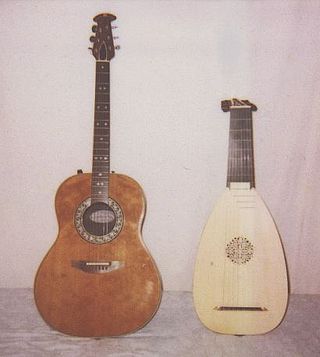
Plucked string instruments are a subcategory of string instruments that are played by plucking the strings. Plucking is a way of pulling and releasing the string in such a way as to give it an impulse that causes the string to vibrate. Plucking can be done with either a finger or a plectrum.
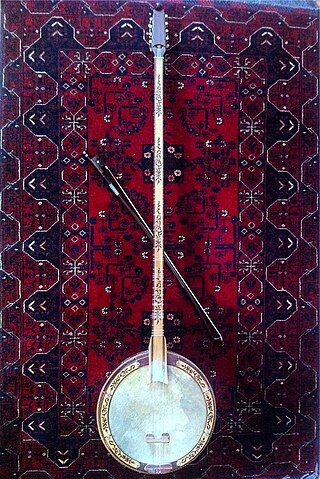
The yaylı tambur is a bowed long-neck lute from Turkey. Derived from the older plucked mızraplı tambur variant of the Turkish tambur, it has a long, fretted neck and a round metal or wooden soundbox which is often covered on the front with a skin or acrylic head similar to that of a banjo.
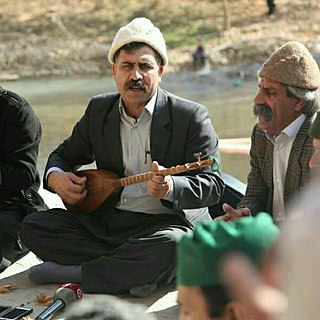
The term Tanbur can refer to various long-necked string instruments originating in Mesopotamia, Southern or Central Asia. According to the New Grove Dictionary of Music and Musicians, "terminology presents a complicated situation. Nowadays the term tanbur is applied to a variety of distinct and related long-necked lutes used in art and folk traditions. Similar or identical instruments are also known by other terms." These instruments are used in the traditional music of Iran, India, Kurdistan, Armenia, Afghanistan, Azerbaijan, Pakistan, Turkey, Tajikistan, Kazakhstan, and Uzbekistan.

The tambur is a fretted string instrument of Turkey and the former lands of the Ottoman Empire. There are two variants, one of which is played with a plectrum and the other with a bow. The player is called a tamburî.

The tanbūra or "Kissar" is a bowl lyre of East Africa and the Middle East. Tanbūra traces its etymology to the Persian tanbur via the Arabic tunbur, though this term refers to long-necked lutes. The instrument probably originated in Upper Egypt and the Sudan in Nubia and is used in the Fann At-Tanbura in the Persian Gulf Arab States. It also plays an important role in zār rituals.

The tambouras is a Greek traditional string instrument of Byzantine origin. It has existed since at least the 10th century, when it was known in Assyria and Egypt. At that time, it might have had between two and six strings, but Arabs adopted it, and called it a tanbur. The characteristic long neck bears two strings, tuned five notes apart.
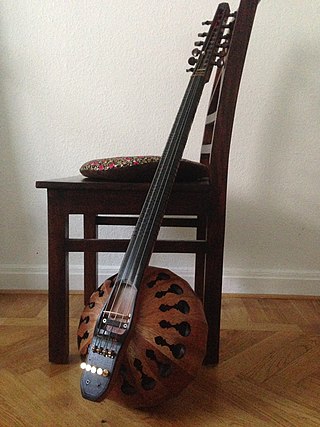
The tarhu is a type of string instrument invented by Australian musician and craftsman Peter Biffin during the 1980s. The tarhu has a long slender neck made of Blackwood, a small round body also made of Blackwood, and four strings about the length of 80 cm It is a flexible instrument that can be played in both plucked and bowed styles derived from both eastern and western cultures.
The bulgari or boulgari is a string instrument that originates from Turkey, especially from Anatolia among the Oghuz Turks living in the Taurus Mountains, similar to the bağlama and the çağür, especially to Egypt and Crete. belonging to the 'tampoura' family and closely related to the 'tzoura', it is played with strings plucked with a pick. This long-necked lute first appeared towards the end of the 18th century and became well-known after 1915 through the Greeks of Asia Minor. It was mainly played in Rethimno during the mid-war and owes its popularity to Stelio Foustalieri. It is rarely come across in Crete today.

Lutes are stringed musical instruments that include a body and "a neck which serves both as a handle and as a means of stretching the strings beyond the body".